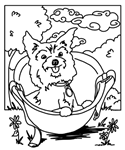Activities

Hand Crafts

Brain Teasers

Coloring Pages

Fun Hand Crafts

Brain Teasers
How well do you know your Military Mascots?
An online quiz by the US Department of Defense to test your knowledge about which animal has been selected by the different branches of military service.
Crossword Puzzles
Military Academy Mascots
How well did you do on the Military Mascot Brain Teaser? That’s where you’ll find the answers for this quick crossword puzzle.
Camel Facts
Our Camel helpers are fascinating creatures. How many of these do you know?
Dogs for the Deaf and Blind
These intelligent partners help to guide those with hearing and sight problems. We’ve included a handy and informative (hint, hint >> puzzle clues) classroom resource sheet with the puzzle.

Coloring Pages
 Discovered at Yale University in 1917, during training for the 102nd Infantry, this stray Boston Terrier mix was befriended by Corporal James Robert Conroy who would later smuggle Stubby onto the ship transporting troops to France. Upon their arrival overseas, Stubby was discovered by Conroy’s commanding officer. Stubby performed his salute, a trick taught to him by Conroy, which led to his being allowed to stay with the troops as they entered World War I. During his eighteen months with the 102nd Infantry, Stubby alerted his troops to incoming artillery and mustard gas, helped locate wounded soldiers, improved the morale in camp with his antics, and was credited with capturing a German Spy, which led to the unit’s commander recommending Stubby for the rank of sergeant. He was presented with a coat by grateful locals that would later display his many medals earned on the battlefields of France. After the war, Stubby returned to the United States, and was treated like a celebrity, riding in many parades, and meeting Presidents Woodrow Wilson, Calvin Coolidge, and Warren G. Harding. Sergeant Stubby is now preserved and on display at the Smithsonian National Museum of American History. A life-size bronze sculpture, titled “Stubby Salutes,” was created for Robert Conroy’s family by Susan Bahary in 2018, and was installed at the Cleveland Metroparks’ Rocky River Reservation in Lakewood, Ohio.
Discovered at Yale University in 1917, during training for the 102nd Infantry, this stray Boston Terrier mix was befriended by Corporal James Robert Conroy who would later smuggle Stubby onto the ship transporting troops to France. Upon their arrival overseas, Stubby was discovered by Conroy’s commanding officer. Stubby performed his salute, a trick taught to him by Conroy, which led to his being allowed to stay with the troops as they entered World War I. During his eighteen months with the 102nd Infantry, Stubby alerted his troops to incoming artillery and mustard gas, helped locate wounded soldiers, improved the morale in camp with his antics, and was credited with capturing a German Spy, which led to the unit’s commander recommending Stubby for the rank of sergeant. He was presented with a coat by grateful locals that would later display his many medals earned on the battlefields of France. After the war, Stubby returned to the United States, and was treated like a celebrity, riding in many parades, and meeting Presidents Woodrow Wilson, Calvin Coolidge, and Warren G. Harding. Sergeant Stubby is now preserved and on display at the Smithsonian National Museum of American History. A life-size bronze sculpture, titled “Stubby Salutes,” was created for Robert Conroy’s family by Susan Bahary in 2018, and was installed at the Cleveland Metroparks’ Rocky River Reservation in Lakewood, Ohio.
To see a photo of Stubby and his sculpture, click here.
 Smoky, a 4 lb Yorkshire Terrier, was found in an abandoned foxhole in the New Guinea jungle during World War II. For the next two years, she accompanied Corporal William A. Wynne and the 5th Air Force, 26th Photo Reconnaissance Squadron on twelve air/sea missions, and was awarded eight battle stars. She survived 150 air raids on New Guinea, a typhoon at Okinawa, and a solo parachute jump. Nicknamed the “angel from a foxhole,” Smoky warned troops of incoming attacks and used her small size to their advantage by helping to run a communications wire through an 8″ wide pipe that ran 70 feet through their Luzon airbase. After the war, she returned to Cleveland, Ohio with Corporal Wynne, often performing tricks and making guest appearances on television shows, and at veterans’ hospitals. Nearly 50 years later, on Veterans Day, November 11, 2005, a monument dedicated to “Smoky, the Yorkie Doodle Dandy, and the Dogs of All Wars,” was created by Susan Bahary, and installed in the Rocky River Reservation of Cleveland Metro Parks.
Smoky, a 4 lb Yorkshire Terrier, was found in an abandoned foxhole in the New Guinea jungle during World War II. For the next two years, she accompanied Corporal William A. Wynne and the 5th Air Force, 26th Photo Reconnaissance Squadron on twelve air/sea missions, and was awarded eight battle stars. She survived 150 air raids on New Guinea, a typhoon at Okinawa, and a solo parachute jump. Nicknamed the “angel from a foxhole,” Smoky warned troops of incoming attacks and used her small size to their advantage by helping to run a communications wire through an 8″ wide pipe that ran 70 feet through their Luzon airbase. After the war, she returned to Cleveland, Ohio with Corporal Wynne, often performing tricks and making guest appearances on television shows, and at veterans’ hospitals. Nearly 50 years later, on Veterans Day, November 11, 2005, a monument dedicated to “Smoky, the Yorkie Doodle Dandy, and the Dogs of All Wars,” was created by Susan Bahary, and installed in the Rocky River Reservation of Cleveland Metro Parks.
You can see photos and learn more about Smoky here!
 Dromedary camels earned their nickname “Ships of the Desert” due to their ability to carry heavy loads over long distances across hot, dry terrain. Though native to eastern Africa and western Asia, Dromedary camels have been successfully used in the western United States to pack equipment during the surveys of the now historic Route 66, and currently are used to pack supplies and seedlings into Joshua Tree National National Park for their burn area reforestation.
Dromedary camels earned their nickname “Ships of the Desert” due to their ability to carry heavy loads over long distances across hot, dry terrain. Though native to eastern Africa and western Asia, Dromedary camels have been successfully used in the western United States to pack equipment during the surveys of the now historic Route 66, and currently are used to pack supplies and seedlings into Joshua Tree National National Park for their burn area reforestation.
To learn more about these fascinating animals, click here!

Bactrian camels are easily identified by their two humps (like the letter “B” on its side). Native to the Gobi Desert of Northern China and Mongolia, these camels can withstand the extreme cold in the winters with their thick, woolly undercoat, and long, rough outer coat. Their heavy hair sheds in large clumps in late spring and can be used to spin into yarn or be felted to make hats and saddle pads. Bactrian camels range from pale sandy cream to rusty red to dark chocolate brown.
Due to their curious, sensitive nature, and unusual anatomical characteristics, camels are finding their way into therapeutic programs across the United States, as an animal that at once draws attention and focus, and is docile and sturdy enough to enjoy physical contact.
To learn more about these fascinating animals, click here!
Let's Build it!
News
Contact Us
5662 Calle Real #105
Goleta, CA 93117
Email: info@NSAMproject.org
Phone: 202-774-1992
NSAM is a 501 (c)(3) non-profit organization.
EIN #27-4620979

